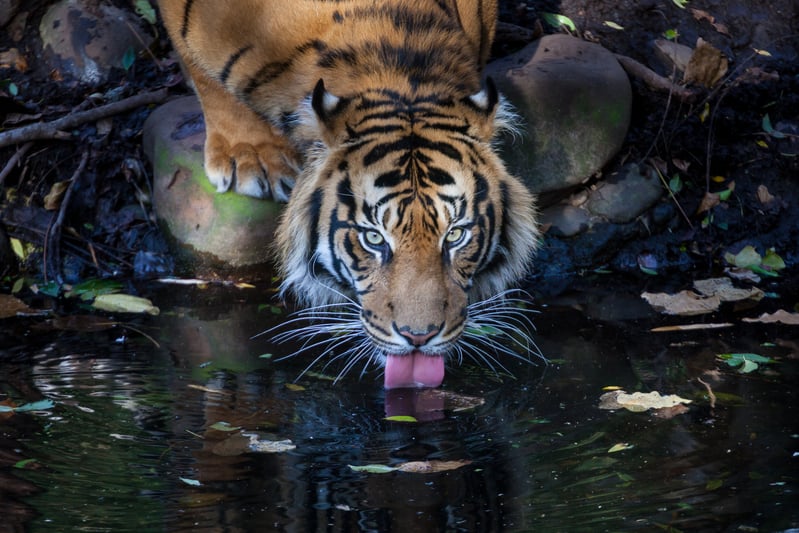1. Polar bears aren’t really white
It’s true. Polar bears actually have black skin (take a look at their noses) that’s covered in transparent, pigment-free hair. Each individual polar bear hair scatters and reflects visible light which makes polar bears appear white, even though they’re not – sneaky.

A young polar bear (Ursus maritimus) wanders on ice, seen from the Greenpeace ship during an expedition to document the lowest sea ice level on record.
2. Sperm whales sleep standing up
It’s a bit hard to fathom, and doesn’t sound especially comfortable, but sperm whales sleep vertically, dangling tail downwards. In fact whales ‘sleep’ by switching only half of their brain off at a time (don’t try this at home) and this position makes it easiest for a dozing whale to breath out of its blowhole.

A sperm whale calf breaks the surface, Sri Lanka.
3. A turtle’s sex is determined by temperature
Whether sea turtle hatchlings are born male or female depends on the temperature of where they happen to be located in the nest. If it’s warmer than the “pivotal temperature” (28 – 29 degrees Celsius), the turtle is born female, if it’s colder, male.

Sea turtles used to be a rare sight in the waters of Apo Island. Since it was declared a marine reserve, it is now common to see Hawksbill and Green Sea Turtles such as this one with remoras hitching a ride.
4. Tigers have the brightest eyes of any animal
The eye of the tiger is backlit by a membrane that reflects light through the retina. Thanks to this, tigers have the brightest – and, in my opinion, the most beautiful – eyes in nature.

A semi-wild Sumatran Tiger (Panthera Tigris Sumatrae) is seen at the Tambling Wildlife Nature Conservation rescue centre, which is part of the South Bukit Barisan National Park.
5. Orangutans are ticklish
There are two kinds of ticklish. There’s the gentle kind that feels itchy, and the kind that makes you laugh uncontrollably. Many animals are the first kind of ticklish – it’s an evolutionary behavior that helps them ward off potentially dangerous animals and insects. But only very few animals are the second kind of ticklish. In fact, it seems to be just us humans and our very closest primate relatives, including the orangutans.

Baby orangutan at Orangutan Foundation International Care Center in Pangkalan Bun, Central Kalimantan. Expansion of oil palm plantations is destroying their forest habitat.
6. Polar bears don’t need to drink water
Obvious fact alert: most of the fresh water in the Arctic is frozen. For you and I that might cause some problems. But not for polar bears – they’ve evolved so that they no longer need to drink water. They can get all the H2O they need from the chemical reaction that breaks down fat.

Polar bear jumping on iceflow, Herald Island, Chukchi Sea.
7. Sperm whales have the biggest brain of any animal, ever
Not only is it the biggest animal with teeth, it’s also got the smarts. The world’s largest true predator has a brain over 5 times as heavy as ours.

A pod of Sperm Whales move into a defense line to stop a pod of Orcas (Killer Whales) getting to their calf, off the coast of Sri Lanka.
8. Sea turtles talk to each other before they hatch
People used to think that turtles didn’t make noises. But now we know that’s just not true. In fact, sea turtles talk to each other before they’ve even hatched. While still in their individual eggs, turtles communicate with each other by making sounds. Researchers believe they do this in order to coordinate their hatching times (now, if that’s not adorable).

Leatherback turtle eggs on Jamursba Medi beach, Tambrau District, West Papua. Leatherback turtles are the largest marine turtle species and are considered living dinosaurs as the species have been virtually unchanged for the last 100 million years. The species is critically endangered and may face extinction within the next three decades.
9. Orangutans love the taste of soap
Not only do they love durian, the smelliest fruit I’ve ever come across, but they also happen to enjoy the taste of soap which, surprisingly, doesn’t upset their stomachs. Though in many ways we’re very similar to orangutans, I wouldn’t suggest trying either at home…

Orangutans at a feeding station run by Orangutan Foundation International. The area, near Tanjung Harapan village, Kumai District, Central Kalimantan, has recently been removed from the Tanjung Puting National Park and allocated to the oil palm company PT Andalan Sukses Makmur, a subsidiary of Bumitama Agri Ltd.
10. Polar bears have blue tongues
The photo says it all really 🙂

11. Humpback whales follow & create musical trends
Humpback whales love to sing. But they don’t just trot out the same old tune. Over time the songs change, and evolve, and if they like a bit of something they hear another whale singing – rather than just have that earworm stuck in their head – they will incorporate it into their own repertoire. If it’s catchy enough, it will spread to neighboring whales and then to populations farther and farther across the sea!

Humpback whale with young.
12. Tiger urine smells like buttered popcorn
There’s an interesting fact for you – use it wisely.

A Sumatran tiger.
You just can’t imagine a world without these amazing animals can you?
But they’re under serious threat. Their habitats are being destroyed by climate change, polluting corporations and greedy palm oil companies.
Our movement is fighting back. Will you help us get the word out? Share these 12 amazing facts about endangered species now!






